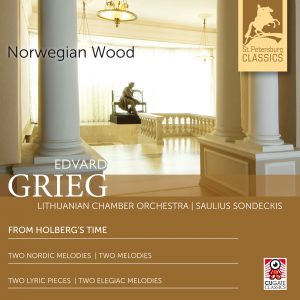 Facts & Figures
Facts & Figures
In this wholeness the album contains a rarely compiled collection of smaller masterpieces Edvard Grieg had composed for string orchestra. It is not a coincidence though that most of the pieces are transformations of initially different formats. Edvard Grieg was famous as a pianist and as a composer for the piano during his life. His studies at the Leipzig Conservatory with teachers such as Ignaz Moscheles and Carl Reinecke, who both were renowned as virtuoso players all over Europe, had shaped this part of his artistry. So many of his works were originally composed for the keyboard instrument which seemed to be the appropriate means of communicating the Nordic folk music idiom, which Grieg transferred perfectly well into art music.
But at the same time this type of music, lighter in character and rather easy-going was also congenial to another instrumental platform in chamber music, where the intimacy of the origin could both be kept and extended: the string section or the string orchestra. Having its origin in earlier epochs, particularly in the 18th century, the string band had mostly gone with the advent of the large romantic symphony orchestra. But as a backlash 19th century composers rediscovered the virtues of this orchestral formation, which is able to have the spirit of bygone ages revived. Intimacy and transparency of musical handwriting found a special platform here.
This was the initial situation when Grieg was asked to write in 1884 some music for the 200th anniversary of the birth of Ludvig Holberg, the great Danish comedy writer, whose art was at the same time regarded by all Nordic territories as a transboundery cultural heritage. So Grieg composed a “Suite in the Old Style” with the official title “From Holberg’s Time”. Originally it is designed for piano, but the spirit of the musical character in the form of a Baroque dance suite was in a way asking for a transcription for string orchestra. The titles of the movements, the rhythms and melodies let the listener anticipate an 18th century piece of music, however the harmonic ingredients are true 19th century.
The bunch of Nordic Melodies complementing the Suite is following the same pattern. These beautiful miniatures disclose the difference between the piano and the string band version: the orchestra with its ability of grounding harmonies, playing dynamically with tones and phrases are probably even better suited to carry on the melancholy themes and moods than the piano with its more transient sustainability. So the string arrangement gives a perfect testament of what Grieg’s music with its special Nordic idiom is about: authentic varying moods full of melancholy, surprising harmony modulation, use of organ points combined with open fifths and last but not least endless melodies anticipating in some parts the Impressionism.
But of course both are respectable versions in its own right.
The present release comes from the 24 bit /96 khz state-of-the-at recordings out of the CuGate Classics archive. They are carefully remastered by the prestigious Grammy award-winning b-sharp studio Berlin using the original source material. Liner notes in English.
Saulius Sondeckis was one of the most versatile musicians of the former Soviet Union. As an educated violinist, conductor, orchestra leader and teacher he shaped generations of musicians, both instrumentalists and vocalists.
Born on 11 October 1928 in Šiauliai (Lithuania) he studied violin at the Lithuanian Academy of Music and Theatre with Professor Alexandras Livontas. As this teacher was a student of David Oistrakh, Sondeckis himself might be called a „musical grandson“ of the famous Russian violinist. After his graduation and stages as teacher at the Juozas-Tallat-Kelpša Conservatory and the National Mikalojus-Konstantinas-Ciurlionis School of Arts in Vilnius he successfully completed his studies at the Moscow Conservatory. In 1960 he founded the Lithuanian Chamber Orchestra and worked there as artistic director and principal conductor until 2004. From 1963, he continued his education, studying conducting with Igor Markevich at the Moscow Conservatory. In 1977 he became professor at the Vilnius Conservatory. As of 1989 he was conducting the St. Petersburg State Hermitage (Camerata) and from 2005 the Kremerata Baltica Chamber Orchestra.
Sondeckis was a member of the Herbert von Karajan Foundation in Berlin and was a coveted juror at many major international competitions, including Mozart in Salzburg, Tchaikovsky in Moscow and Toscanini in Parma. A honorary member of the Lithuanian Musicians‘ Union he is one of the most decorated characters in contemporary classical music in Lithuania, including People‘s Artist of the USSR (1980), Laureate of the USSR State Award (1987) and winner of the Lithuania National Award (1999).
He died on 3 February 2016 in Vilnius where he is buried in the Antalkalnis Cemetery.

